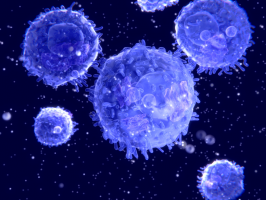
Six months after receiving a single dose of tisagenlecleucel, a CAR T-cell therapy that targets CD-19, high response rates persist among adult patients with relapsed or refractory diffuse large B-cell lymphoma (DLBCL), according to researchers.
This data was presented in a press conference at the 2017 ASH annual meeting.
For more information watch our interview with Dr Schuster.
This latest interim analysis of the international JULIET trial showed that for 46 patients with at least 6 months of follow-up, the overall response rate was 37 percent, with 30 percent achieving a complete response and 7 percent achieving a partial response.
What’s more, according to researchers, this observation indicates that, among 81 patients treated, those whose signs of cancer had gone away at 3 months remained relapse-free at 6 months and beyond.
“While we don’t completely understand why these remissions are so durable, it’s exciting and will change how this disease is treated when conventional therapies fail,” said lead study author Stephen Schuster, MD, Professor of Haematology/Oncology in the Perelman School of Medicine at the University of Pennsylvania (Penn) and Penn's Abramson Cancer Center.
“We are going to be able to offer patients who don’t respond to standard therapies a form of therapy that may, after a single treatment, relieve symptoms and save lives.”
DLBCL is the most common form of lymphoma, accounting for roughly one-third of all non-Hodgkin lymphoma cases.
While current therapy is successful for many people with this disease, those not responding to current treatments face a poor prognosis with limited treatment options.
According to Dr. Schuster, primary therapy will fail in about one-third of people with DLBCL, and half of these patients will not be candidates for stem cell transplantation, which is considered the best second-line treatment approach; such patients would be candidates for this type of therapy.
This single-arm, open-label Phase II trial is the largest study examining a CAR T-cell therapy exclusively in people with DLBCL.
It is being conducted at 27 sites spanning 10 countries across North America, Europe, Australia, and Asia.
Enrollees had received two or more lines of prior chemotherapy and had disease progression, or had failed to respond or were ineligible for autologous stem cell transplant.
Patients ranged in age from 22 to 76 years old.
Subgroup analyses showed no difference in outcomes based on prior DLBCL treatment or risk factors.
Of the 81 patients included in JULIET, the responding patients continue to be followed without any additional therapy, and median durable overall response and overall survival have yet to be reached.
Most of the adverse events were seen shortly after infusion and included CRS and neurotoxicities.
There were no deaths attributable to CTL019, CRS, or neurological events.
Dr. Schuster said several factors set this trial apart from other investigations of CAR T-cell therapies, including that the therapy was done on an outpatient basis for many patients (26 percent) and the manufacturing process allowed investigators to generate CAR T cells from previously collected and frozen blood cells, permitting successful shipment around the world.
“Once the CAR T cells were generated, we could freeze them again, allowing us to hold the product until patients were clinically ready to receive them,” he said. “These are very sick patients, so this gives the treating physician some flexibility to schedule therapy when it’s best for each patient.”
Patients in the JULIET trial who responded to therapy continue to be followed carefully for recurrence of their lymphoma and recovery of their immune system.
Source: ASH 2017